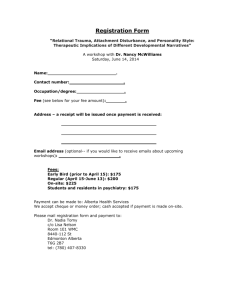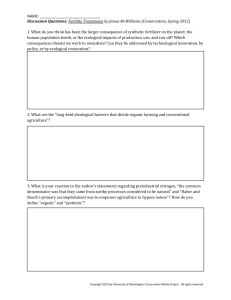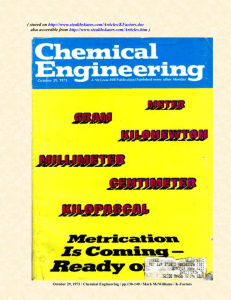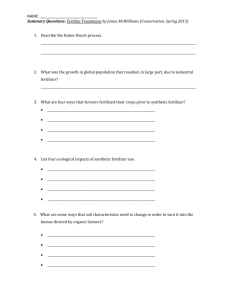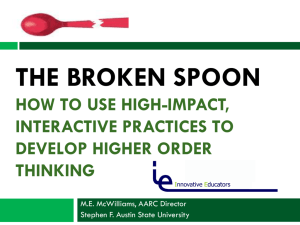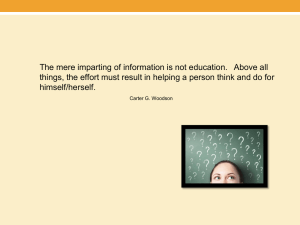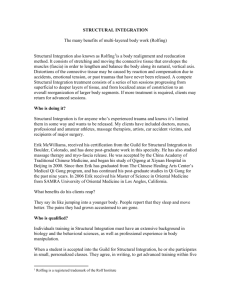Reviewing the SIX FACETS of Understanding
advertisement
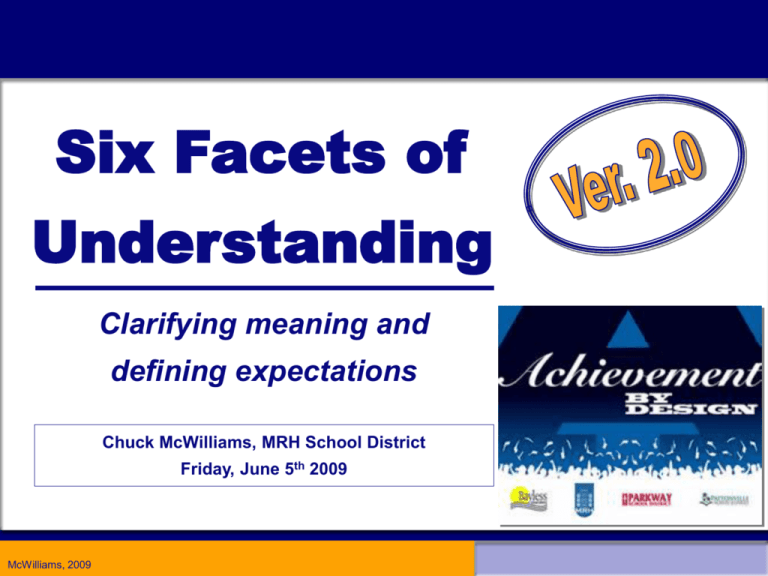
Six Facets of Understanding Clarifying meaning and defining expectations Chuck McWilliams, MRH School District Friday, June 5th 2009 McWilliams, 2009 "There is nothing so terrible as activity without insight." -Johann Wolfgang von Goethe German Playwright, Poet, Novelist and Dramatist. 1749-1832 McWilliams, 2009 Our Shared Thinking as UbD Designers • The teacher’s job is to “uncover” the big ideas contained in content standards and to ensure they are understood, not to provide merely fun activities or cover a textbook or cover a textbook’s content. • The job of the teacher requires “thinking like an assessor” - doing research into one’s practice, and adjusting practice and designs in light of sought-after results/feedback. Wiggins, Grant, & McTighe, Jay. (1998). Understanding by Design. ASCD. McWilliams, 2009 A Few Great Thinkers! Benjamin Bloom Jay McTighe Grant Wiggins Norman Webb Bloom’s Taxonomy McWilliams, 2009 Depth of Knowledge Facets of Understanding Introducing… Evaluation High Synthesis Analysis Benjamin Bloom Application Comprehension Bloom’s Taxonomy McWilliams, 2009 Knowledge Low A Newer Look? Lorin Anderson and David Krathwohl Revised Bloom’s Taxonomy McWilliams, 2009 Evaluation Creating Synthesis Evaluating Analysis Analyzing Application Applying Comprehension Understanding Knowledge Remembering Knowledge or Remembering • Observing and recalling information • Knowledge of dates, events, places • Knowledge of major ideas • Mastery of subject matter • Content knowledge! McWilliams, 2009 Key Words: List, Define, Tell, Describe, Identify, Show, Label, Collect, Examine, Tabulate, Quote, Name, Who, When, Where Comprehension or Understanding • Understanding information • Grasping meaning • Translating knowledge into new context • Interpreting facts, comparing, contrasting • Ordering, grouping, inferring causes • Predicting consequences McWilliams, 2009 Key Words: Summarize, Describe, Interpret, Contrast, Predict, Associate, Distinguish, Estimate, Differentiate, Discuss, Extend Application or Applying • Using information • Using methods, concepts, theories in new situations • Solving problems using required skills or knowledge • Carrying out a procedure that implements previously learned knowledge McWilliams, 2009 Key Words: Apply, Demonstrate, Calculate, Complete, Illustrate, Show, Solve, Examine, Modify, Relate, Change, Classify, Experiment, Discover Analysis or Analyzing • Seeing patterns • Organizing parts • Recognizing hidden meanings • Identifying components • “Connecting the dots” McWilliams, 2009 Key Words: Analyze, Separate, Order, Explain, Connect, Classify, Arrange, Divide, Compare, Select, Explain, Infer Synthesis or Creating • Using old ideas to create new ones • Generalizing from given facts • Relating knowledge from several areas • Preparing a solution • Drawing conclusions McWilliams, 2009 Key Words: Combine, Integrate, Modify, Rearrange, Substitute, Plan, Create, Design, Invent, What if?, Compose, Formulate, Prepare, Generalize Evaluation or Evaluating • Comparing and discriminating between ideas • Assessing value of theories and ideas • Making choices based on reasoned argument • Verifying the value of evidence • Recognizing subjectivity McWilliams, 2009 Key Words: Assess, Decide, Rank, Grade, Test, Measure, Recommend, Convince, Select, Judge, Discriminate, Support, Conclude, Compare, Summarize Using Bloom’s Taxonomy in Unit Planning • How can Bloom’s ideas be applied in unit planning? • What might be some other ways to use Bloom’s taxonomy? • Share examples of ways you’ve used Bloom’s. McWilliams, 2009 Introducing… Level 4 - Extended Thinking Level 3 - Strategic Thinking Norman Webb Level 2 - Skill/Concept Depth of Knowledge Level 1 - Recall McWilliams, 2009 Level 1 - Recall • Automatic recognition • Remembering lists/numbers • Recognition of concept/formula • Simple processes/procedures • Application in situations or tasks • Basic facts McWilliams, 2009 Key Words: Recite, Recognize, Name, Use, Illustrate, Measure, Define, Draw, List, Identify, Memorize Recall, Repeat, State, Tell DOK Level 1 Examples • List animals that survive by eating other animals. • Identify elements of music using musical terminology. • Recall facts explicitly found in text. • Describe physical features of places. • Determine the perimeter or area of rectangles given a drawing or labels. • Identify basic rules for participating in simple games and activities. McWilliams, 2009 Level 2 - Skills/Concepts • Understanding of concepts • Recognition of skills • Application of skills in new problems • Gather, organize, and remember data • Interpret simple graphics • Drawing proper conclusions McWilliams, 2009 Key Words: Compare, Classify, Infer, Categorize, Construct, Predict, Interpret, Relate, Estimate, Distinguish, Summarize, Show DOK Level 2 Examples • Compare desert and tropical environments. • Identify and summarize the major events, problems, solutions, conflicts in text. • Explain the cause-effect of historical events. • Predict a logical outcome based on information in a reading selection. • Explain how good work habits are important at home, school, and on the job. • Describe various styles of music. McWilliams, 2009 Level 3 - Strategic Thinking • Examine all aspects of a problem • Reflect on circumstances • Synthesize concepts for use in problem solving • Generate new ideas/solutions • Evaluate effectiveness • Provide rationale Key Words: in decision-making Revise, Assess, Construct, Investigate, Differentiate, Formulate, Draw • Justifies procedures Conclusions, Develop a Logical Argument, Cite Evidence, Hypothesize McWilliams, 2009 DOK Level 3 Examples • Compare consumer actions and analyze how these actions impact the environment. • Analyze or evaluate the effectiveness of literary elements (e.g. characterization, setting, point of view, conflict and resolution, plot structures). • Solve a multiple-step problem and provide support with a mathematical explanation that justifies the answer. McWilliams, 2009 Level 4 - Extended Thinking • Thinking “outside the box” • Expanding on ideas • Asking “What if…” • Producing a complex product • Interpreting different points of view without demonstrating personal bias McWilliams, 2009 Key Words: Create, Prove, Analyze, Critique, Apply Concepts, Synthesize, Connect, Design, Simulate DOK Level 4 Examples • Develop a scientific model for a complex idea. • Propose and evaluate solutions for an economic problem. • Explain, generalize or connect ideas, using supporting evidence from a text or source. • Create a video that represents the characteristics of a culture. McWilliams, 2009 Using the DOK in Unit Planning • How can DOK be applied in unit planning? • What might be some other ways to use the DOK model? • Share examples of ways you’ve used DOK. McWilliams, 2009 Hey! What’s the Big Idea? Jay McTighe Grant Wiggins Facets of Understanding McWilliams, 2009 What is knowledge? Declarative Knowledge Knowing WHAT Procedural Knowledge Knowing HOW Structural Knowledge Knowing WHY -Jonassen, Computers as Mindtools for Schools, 2000 McWilliams, 2009 Structure of Knowledge Principles and Generalizations Key Concepts and Core Processes Facts and Skills Wiggins, Grant, & McTighe, Jay. (1998). Understanding by Design. ASCD. McWilliams, 2009 Establishing Curricular Priorities worth being familiar with important to know and do “big ideas” worth understanding “nice to know” foundational concepts & skills enduring understandings Wiggins, Grant, & McTighe, Jay. (1998). Understanding by Design. ASCD. McWilliams, 2009 How It All Fits Together McWilliams, 2009 The Six Facets of Understanding Explanation _______ Self-Knowledge Superficial Coverage vs. Uncovering Big Ideas Wiggins, Grant, & McTighe, Jay. (1998). Understanding by Design. ASCD. McWilliams, 2009 Reviewing the SIX FACETS of Understanding What’s the name of this facet? It’s described as… • Telling meaningful stories • Offering apt translations • Revealing historical or personal dimension to ideas and events • Making the object of understanding personal I Why it’s Interpretation, of course! Wiggins, Grant, & McTighe, Jay. (1998). Understanding by Design. ASCD. McWilliams, 2009 Reviewing the SIX FACETS of Understanding What’s the name of this facet? E It’s described as… • Making generalizations • Justifying facts and data • Providing insightful connections, illuminating examples, and detailed illustrations Why it’s Explanation, of course! Wiggins, Grant, & McTighe, Jay. (1998). Understanding by Design. ASCD. McWilliams, 2009 Reviewing the SIX FACETS of Understanding What’s the name of this facet? It’s described as… • Effectively using knowledge • Adapting knowledge and skills in diverse and real contexts • “Doing” the subject Why it’s , of course! Wiggins, Grant, & McTighe, Jay. (1998). Understanding by Design. ASCD. McWilliams, 2009 Reviewing the SIX FACETS of Understanding What’s the name of this facet? It’s described as… • Seeing and hear points of view through critical eyes and ears P • Seeing the “big picture” Why it’s Perspective, of course! Wiggins, Grant, & McTighe, Jay. (1998). Understanding by Design. ASCD. McWilliams, 2009 Reviewing the SIX FACETS of Understanding What’s the name of this facet? It’s described as… • Showing metacognitive awareness • Being aware of what we don’t understand SK • Perceiving what shapes our own understanding Why it’s Self-Knowledge, of course! Wiggins, Grant, & McTighe, Jay. (1998). Understanding by Design. ASCD. McWilliams, 2009 Reviewing the SIX FACETS of Understanding What’s the name of this facet? It’s described as… • Finding value in what others might find odd, alien, or implausible E • Perceiving sensitivity on the basis of prior direct experience Why it’s Empathy, of course! Wiggins, Grant, & McTighe, Jay. (1998). Understanding by Design. ASCD. McWilliams, 2009 The Six Facets of Understanding Explanation _______ Self-Knowledge Superficial Coverage vs. Uncovering Big Ideas Wiggins, Grant, & McTighe, Jay. (1998). Understanding by Design. ASCD. McWilliams, 2009 Using the Six Facets in Unit Planning • How can the Theory of Understanding be applied in unit planning? • What might be some ways to use the Six Facets? • Share examples of ways you’ve used the Six Facets McWilliams, 2009 Using UbD in a Sophomore Biology Class Chuck McWilliams, Biology Teacher Maplewood-Richmond Heights HS Maplewood, MO McWilliams, 2009 Planning For a “New” Course • Develop Course Enduring Understandings Ex.) Life functions as a complex system that exists at many different levels • Develop Essential Questions Ex.) How can scientists lead us to understanding how life functions as a system? • Develop course assessments - semester exams • Develop individual units and assessments McWilliams, 2009 A “New” Biology Course • How does a(n) ________ come to know the world and humans’ place in it? • Each of the eight instructional units focuses on the Perspective of a scientist • During the year, each student will become a: – – – – McWilliams, 2009 Biologist Ecologist Biochemist Cell Biologist – – – – Molecular Biologist Geneticist Naturalist Taxonomist Learning from Different Perspectives Cell Biologist Molecular Biologist Biochemist Geneticist Ecologist Biologist Naturalist Student Taxonomist Biology: Exploring Multiple Scientific Perspectives McWilliams, 2009 Sample Unit: Unit 6 - Geneticist Enduring Understandings: 1. Patterns of inheritance can be predicted in living things. 2. Genetic and environmental factors determine the physical characteristics of living things. 3. As genetic research continues, society will face ethical challenges. Participating in the ethical decision making process will require carefully analyzing scientific research and understanding different points of view. McWilliams, 2009 EU Essential Questions What will Guide My Students? • If offspring inherit their parents genes, then why don’t they look exactly like their parents? • What effect does the environment have on gene expression? • How will scientists use the information from generated the Human Genome Project? McWilliams, 2009 Performance Assessment How will I know my students understand? • PersonaGen® Array 119™ Genetic Test • Students receive a simulated genetic test (multiple tests all at once) • They must interpret their profile • Research and learn about their assigned “mutations” • Write a 6 paragraph essay detailing their profile and the effect it would have on their personal and career life • Also included in the essay is a discussion/analysis concerning genetic testing in general • In class discussion and rubrics included McWilliams, 2009 How It All Fits Together McWilliams, 2009 How It All Fits Together W W HH How will we hook and hold student interest? EE How will we equip students for expected performances? R How will we help students rethink and revise? R E McWilliams, 2009 Where are we going? Why? What is expected? E T How will students self-evaluate and reflect on their learning? OT How will we tailor the learning plan? O How will we organize and sequence the learning? How It All Fits Together McWilliams, 2009 Some Lessons Learned About Stage 3 • Protecting your favorite activities? • Including FUN activities? • Be aware of TIME and pacing • Scaffold toward the Performance Task and other assessments • Unit Planning vs. Lesson Planning McWilliams, 2009 Reviewing the Ideas In your groups: • Compare/contrast the three models: Bloom’s - DOK Six Facets • Group sharing and discussion McWilliams, 2009 The Thinking Game! McWilliams, 2009 The Key to Success! “We cannot teach people anything; we can only help them discover it within themselves.” Galileo Galilei 16th century Italian scientist - McWilliams, 2009 Have a Great Journey Next Year! McWilliams, 2009
